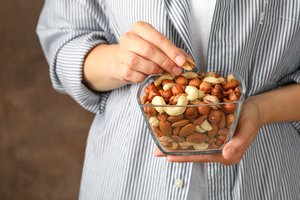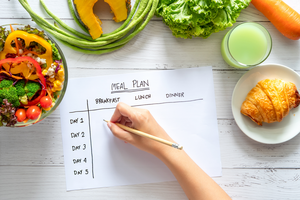In this article:
- Checking in with your fullness levels can help you manage weight and support health.
- It’s good to check in while you’re eating to avoid overeating.
- You can use a hunger and fullness scale that goes from 1-10.
- It’s best to eat slowly and consume nutritious foods to feel full when you’ve eaten the amount of food you need.
- Lark can help you manage weight with or without GLP-1s as you log food, get tips for eating healthier, and make small changes that can turn into healthy habits.
When do you know your meal or snack is over? Is it when there’s no more food? Is it when you run out of time? Is it when everyone leaves the table?
Ideally, you stop eating when you’re full. That’s best for weight and health, as you probably know intuitively if you’ve ever overeaten and felt bloated, lethargic, or generally unwell.
Assessing your fullness can help you determine when it’s time to stop eating. Here’s how you can assess fullness, and what you can do with that information.
How and When to Assess Fullness
You can assess fullness with a similar question as with hunger. Ask yourself,
“How hungry am I on a scale from 1-10, where 1 is absolutely starving, and 10 is absolutely stuffed?”
- John Hopkins Medicine explains what each number means. 1 or 2 means you’re starving, and may feel shaky and weak
- 3 means you’re feeling hungry and are ready to eat
- 4 means you’re starting to feel hunger, and it often means you’ll need food within an hour or so
- 5 means you’re neither hungry nor overly full. It’s a neutral number
- 6 means you’re feeling like you had some food, but you haven’t had enough to last you for hours
- 7 means you’ve had enough to eat to feel full for 3-4 hours
- 8 means you’re about as full as if you had a larger-than-normal meal, but you’re not overly uncomfortable
- 9 or 10 may mean you feel uncomfortable and may have trouble moving. This is how you may feel after overindulging at an all-you-can-eat buffet or at Thanksgiving dinner
It’s smart to assess fullness whenever you’re eating. It can help you determine when it’s best to stop eating, whether to finish what’s on your plate, and whether you need a second helping.
When you’re at a 6 on the hunger and fullness scale, start thinking about ending your meal and snack. Focus on low-calorie foods like vegetables and lean proteins if you haven’t already had plenty of them. It’s best to stop eating when you reach a 7.
Why and How to Eat Slowly
Eating slowly can help prevent indigestion, but there are more reasons to slow down. Healthcare professionals often suggest eating more slowly for people who want to lose weight or prevent weight gain.
Cleveland Clinic says it takes up to 30 minutes to feel full due to hormones and neurotransmitters, which are chemicals in your brain. Here is how the process works.
- When you eat, your stomach muscles expand, which is why your clothes may feel tight after a large meal
- The expanding muscles tell your brain that you’re being fed
- Levels of hormones like leptin, cholecystokinin, and insulin start to rise
- Eventually, your brain realizes that you’re full
At that point, you’re likely to rate your fullness level at least at 7, which is a signal to slow down and stop eating.
Harvard Medical School explains that eating slowly can help you feel full more quickly because when you eat too fast, hormones like CCK and leptin don’t have enough time to communicate with the brain.
Here are some tips to slow down while eating.
- Take small bites, chew each one thoroughly, and swallow before the next bite
- Put down your cutlery between bites
- Notice the sights, aromas, textures, and flavors of the foods on your plate or in your bowl, and in your mouth
- Take time between bites to talk to others at the table if you’re eating with people
Other Factors to Consider When Assessing Fullness
Eating slowly and making sure you’ve been eating for at least 30 minutes before assessing your fullness can help you get a more accurate assessment. Here are some additional factors to consider as you interpret your fullness score and how you should respond to it.
What Foods Are in Your Meal or Snack
Eating nutritious foods can help you feel full when you’ve eaten fewer calories compared to calorie-dense foods like burgers, fries, pizza, bacon, and biscuits. Here are some reasons why.
- Calorie-dense foods have more calories per bite. For example, a bite of broccoli may have 3 calories, while a forkful of rice may have 10 calories
- Calorie-dense foods are often quicker to eat per bite. It usually takes longer to chew and swallow a bite of an apple than, a bite of ice cream.
Think about a plate filled with a grilled chicken salad with whole-grain crackers. Compare that to the same-sized plate filled with beef stroganoff and a cookie.
The chicken salad meal may take longer to eat than the meal with beef stroganoff. It may make you feel more full after only 400 calories compared to after 900 calories.
If you eat calorie-dense foods quickly for a full 30 minutes, you are likely to eat more than you need. Doing this regularly can cause weight gain, not to mention indigestion and other health concerns like insulin resistance or a higher risk for heart disease.
Instead, focus on nutrient-dense foods like these.
- Vegetables
- Fruit
- Lean proteins, like chicken and fish
- Beans, lentils, split peas, and soy products
- Whole grains
Usually, less processed foods take longer to eat and are more satisfying. Here are some examples.
- Fresh fruit is more filling than fruit juice
- Whole grains and whole-grain products are more filling than refined grains and refined grain products
- Raw vegetables and lightly cooked vegetables are more filling than boiled or canned vegetables
- Edamame is more filling than soy-based meat substitutes
Creamy, buttery, sugary, and highly processed foods tend to be less filling.
What Else Is on the Table
Have you ever heard the expression, “There’s always room for dessert?” It’s common for people to, “make room for dessert,” even if their fullness score is a 7 or higher. You may be more likely to continue eating, despite being full, if you are eager for another helping of a favorite food or if you know that there’s a delicious dessert coming.
Your Hydration
Staying hydrated throughout the day can help increase feelings of fullness since your body can mistake thirst for hunger. In addition, drinking water and taking in other low-calorie fluids can increase fullness.
Here are some options.
- Drinking water before meals and between meals to stay hydrated
- Drinking water before meals makes the stomach expand so fullness signals can begin to develop
- Eating a broth-based soup at the beginning of meals to increase fullness on fewer calories
- Having regular or decaf coffee or tea after meals so your fullness assessment has a higher score without having dessert
The effects of drinking fluids at meals can vary by the individual. For several days or a few weeks, take time to notice and record how much you drank and how full you felt when you did your hunger assessment. It can help you learn how to increase your fullness.
Social Cues
What’s going on around you can affect your fullness score and how you respond to it. For example, you’re more likely to stop eating if your tablemates put down their utensils and place their napkins on the plates. On the other hand, you may keep eating, even if you’re full, if they keep eating or order more food.
Clean Plate Club
Sometimes, eating and stopping are habitual. If you grew up a card-carrying member of the “clean plate club,” your tendency may be to stop eating when your plate is empty. It’s healthiest to rid yourself of the habit, since you may not always need everything on your plate.
Here are some tips.
- Have a container on the table or nearby where you can put leftover food to save for another meal
- Serve yourself less than you expect to eat, and do a fullness assessment before serving yourself more
- Scrape the food into a trash can if you don’t want to eat it. Trash belongs in the trash can, not in your body
If you have qualms about wasting food, serving yourself less and saving leftovers can prevent waste. If you end up throwing food away and you feel guilty about people who don’t have enough to eat, consider donating a few dollars to a local food bank. They’ll get nutritious food, and you’ll avoid taking in extra calories.
How Lark Can Help
Weight and health management are easier when you are in tune with your body, and it’s best to assess and respond to hunger appropriately. Lark offers additional tools and support. Your Lark coach is available 24/7 for nutrition and physical activity coaching and tracking. Lark can help you make healthy choices and establish habits that fit into your lifestyle so you can manage weight and support health with or without GLP-1 medications.
Click here to see if you may be eligible to join Lark today!
Reviewed by Heather Tonkins, Lark Health Coach











.webp)




.jpeg)



